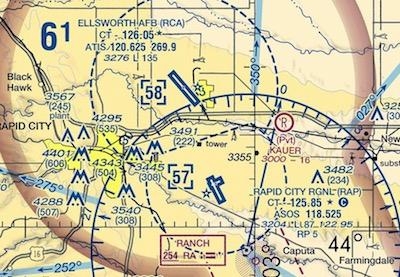Crew Misidentified The Desired Runway For Multiple Reasons, Board Says
The NTSB says that several factors led to the flight crew of Delta Airlines Airbus A320 landing at the wrong airport in Rapid City, SD in July of last year in its probable cause report.

According to the report, On July 7, 2016, at 2042 mountain daylight time (MDT), Delta Air Lines flight 2845, an Airbus A320, N333NW, landed on runway 13 at Ellsworth Air Force Base, Rapid City, South Dakota (RCA). The airplane was not damaged and there were no injuries. The flight was a regularly scheduled passenger flight from the Minneapolis St. Paul International Airport, Minneapolis, Minnesota (KMSP) operating under the provisions of 14 Code of Federal Regulations Part 121, with a planned destination of Rapid City Regional Airport (KRAP).
The flight was routine until nearing the Rapid City terminal area. The crew had initially briefed for landing on runway 32, but the wind had shifted and favored runway 14. The crew reported that they had prepared for the runway 14 approach as well, so the change was not a significant factor. Delta chart material did include an advisory regarding the close proximity and alignment of the two airports.
Landing on runway 14 required more flying distance than runway 32, however, at 2030, the crew discussed the need to descend more rapidly. The flight was not altitude restricted by ATC. At 2035, ATC instructed the flight to fly heading of 300 degrees for the downwind leg of the visual approach. At that time the airplane was 9 miles abeam RAP at 12,000 feet. The ATC controllers noted that the airplane was high and fast for the visual approach. Field elevation of RAP was 3,200 feet and with a nominal remaining flying distance of about 15 to 18 miles the airplane was positioned well above the typical 300 feet per mile descent.
At 2036:30 the captain called the airport in sight and called for gear down and flaps one, configuring the airplane for a more expeditious descent. At this point RAP was southsouthwest of the airplane, at the 8 o'clock position, while RCA was at the 10 o'clock position, therefore, it is likely the captain was actually looking at RCA.

Shortly afterward, ATC issued a vector for base leg, but the crew requested to extend the downwind due to high altitude, which ATC approved.
At 2039, the crew accepted a turn to base leg as the airplane was descending through 5,800 feet, about 5.5 miles north of RCA, and about 12 miles north of RAP. This was consistent with altitudes on the RNAV14 approach to RAP, but a somewhat steeper than normal angle to RCA. ATC cleared the flight for "visual approach runway one-four. Use caution for Ellsworth Air Force Base located six miles northwest of Rapid City Regional." FAA order 7110.65 directs controllers to describe the location of a potentially confusing airport in terms of direction/distance from the aircraft.
During interviews, the crew stated they misheard the controller's warning for the typical position advisory given on an instrument approach, and it supported their idea that the correct landing runway was 6 miles away. The FO did query the Captain if he had the right airport in sight, who expressed some uncertainty. Both crewmembers had little to no experience flying into either RAP or RCA, however, they did not verify their position to the desired landing runway using either the automation, or by querying ATC; and switched off the autopilot and Flight Directors removing possible cues as to their position related to RAP.
At the time ATC cleared the flight for the visual approach the airplane was positioned on the final approach course of the RNAV14 approach, and at a reasonable altitude for that approach, therefore, there was no immediate indication to ATC that the crew had identified the wrong airport.
Shortly after, the captain increased the descent rate as high as 1,200 feet per minute, resulting in an unstable approach as he was focused on the wrong landing runway. The crew realized the mistake just prior to touchdown, but considered it was safer to complete the landing at that point.
The NTSB determined that the probable cause(s) of this incident to be the flight crew's misidentification of the desired landing runway due to excess altitude requiring an extended downwind, and failure to use all available navigation information.
The Miami Herald reports that the Captain on the flight retired from Delta shortly after the incident occurred. The First Officer underwent retraining, and is currently flying for the airline, according to Delta spokesman Michael Thomas.
 ANN's Daily Aero-Term (04.20.24): Light Gun
ANN's Daily Aero-Term (04.20.24): Light Gun Aero-News: Quote of the Day (04.20.24)
Aero-News: Quote of the Day (04.20.24) ANN's Daily Aero-Linx (04.21.24)
ANN's Daily Aero-Linx (04.21.24) Aero-News: Quote of the Day (04.21.24)
Aero-News: Quote of the Day (04.21.24) ANN's Daily Aero-Term (04.21.24): Aircraft Conflict
ANN's Daily Aero-Term (04.21.24): Aircraft Conflict




